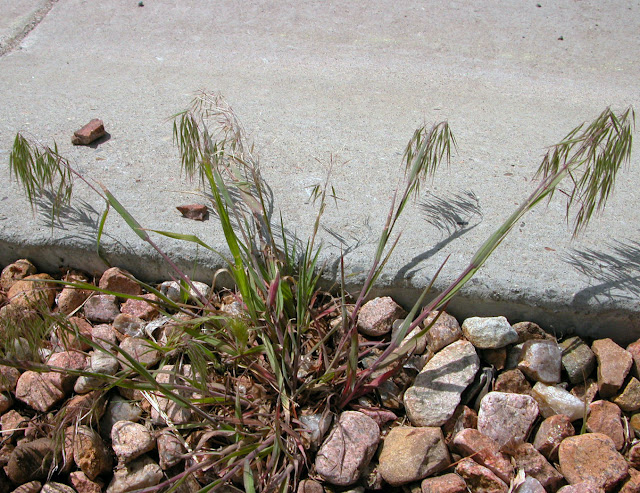Cheatgrass
I don't have to weed my gardens here in the dry southwest the way I constantly did back east. Yes, I have some things that pop up where they shouldn't and I occasionally pull up what isn't wanted. But it's not like the daily effort of whacking back everything all the time that was the core of my gardening efforts in Connecticut.
We do have noxious weeds, though. Cheatgrass is the worst.
This article in the Santa Fe New Mexican describes cheatgrass and what to do about it. I find little tufts of it growing in my gravel along the sidewalk, and I pull them up. It's just a tiny plant with wispy grass blades and by June it has already completed its annual life cycle, setting seeds and browning out.
It doesn't seem like much to worry about, hardly noticeable in the gravel. But when it gets going, this little spindly grass takes over and completely out-competes anything else, forming a monoculture. It forms huge swaths of nothing else, and all summer it is a browned-out fire hazard.
The central medians along Santa Fe's main roads are covered in cheatgrass in summer. I thought the softly waving unbroken stretches of golden grass were boring for street plantings, but looked nice enough . . . until I found out what it was.
It's called cheatgrass because it "cheats" livestock -- since it ripens so quickly in May and June, it provides no food during summer, and the spiky seeds are very painful to touch or browse. It has shallow roots that take the water from deep rooted prairie grasses, cheating them out of scarce moisture.
It is, of course, not native. Bromus tectorum came from Europe and Asia in the 1800s and spread with settlers into the west. Its utter dominance, though, was the result of the settlers' land disturbance -- when native shrubs and grasses were overgrazed by cattle and sheep, bare open land was ripe for takeover by invasive cheatgrass. It loves some bare soil.
It looks so unthreatening as a wispy little grass in my yard. I am forever grateful that I no longer have to weed the way I did endlessly in the east. But I do need to zap this noxious weed as soon as I see it popping up in spring.



Comments